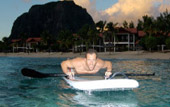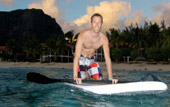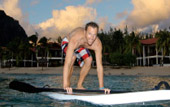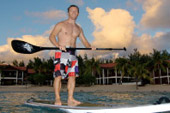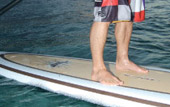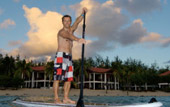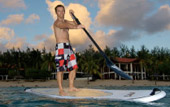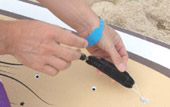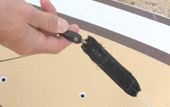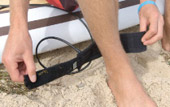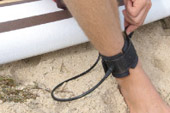| |
| Stand Up Paddle Surfing isn't that hard to learn as unlike normal surfing you can learn to do it on almost any body of water. To start with you will find standing up on the board and paddling will be the trickiest part. If you already surf then the wave riding part should be pretty familiar, except that you will be riding for longer and more often!
An unwritten rule!!! Give respect... (read the advise from the
editor of SUPS mag on the bottom)
The modern Stand Up Paddle boards allow you to catch waves a lot
earlier than even the long boarders. This is great but can lead to
congestion problems on the water at crowded breaks. Here at Bali
Stand Up Paddle we would like to encourage a culture of
respect and sharing. Don't steal all the waves. Ride a few, then let
a few pass under your board. Use your elevated position to call the
sets for the other surfers. Use your paddle to head off to other
peaks on the beach, which maybe you haven't ridden before. In Hawaii
they call it "Surfing with Aloha." It isn't difficult to do, but it
will mean that the sport grows and is respected by other water
users.
If you are taking part in Stand Up Paddle surfing at the moment or
are thinking about taking it up then you can see yourself as a
pioneer of the sport in Bali. Don't be greedy out there - give
respect to gain respect. |
| Before you go on the water with your Stand-Up-Paddle board please: |
|
Adapt the length of the paddle (Mistral adjustable Pacifico paddle 185cm-215cm) to your body height. Rule: The correct
length of the paddle should be one palm on top of your normal height ( see
pic 1 - 3 )
You also have to know your " steering/back foot " - if you do not know this, ask somebody to stand in front of you,
this person should suddenly push you backwards.
The foot you find your balance is then also your back foot for surfing in waves ( see
pic 4 - 5 ) |
| |
|
Take the board to the water - lay yourself and paddle on the board - take the paddle and stand up ( see
pic 6 - 9 ) .
Your feet should be placed next to each other, close to the mast track ( 10 ). take the paddle (hand end) placing one hand on top and the other hand half-meter below; to allow maximum performance from your
paddle. Place the paddle in the water (11), with the curved blade part looking ahead (12) |
|
| You can do about 3-4 paddle strokes on one side before changing to the other side, see illustration showing how to change from one side to other side (13-16). |
|
| To turn the board from one direction to another take a strong paddle passing behind your body and
beyond the tail of the board ( so that it begin to turn). at the same time
stretch your "steering foot - see also point 5" to the back of the board allowing better control (17-20) |
|
| Keep paddling and you will find the board turning into the new direction ( 21-23 ) |
|
|
Please note that is very negligent to go wave surfing without a leash,
please buy a very thick and long leash from a surf shop, first fix the leash to your board ( see
pic 24-25 ) and afterward to your " steering foot - see also point "5" ( see
pic 25 - 27 )
|
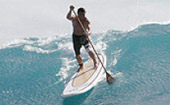 |
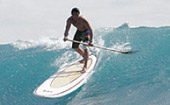 |
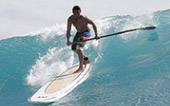 |
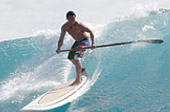 |
| 29 |
30 |
31 |
32 |
Please select smaller
waves in the early stages and check the direction and the way it's running. You always have to paddle towards the " running side = open side". Once you see a wave coming closer, start to paddle as much
and fast as you can.
Keep your feet close together - close to the mast track - see also point 10 (
pic 29 ). |
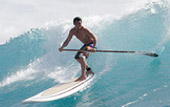 |
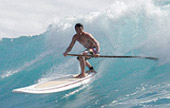 |
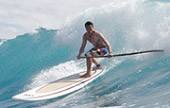 |
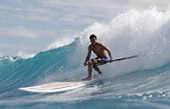 |
| 33 |
34 |
35 |
36 |
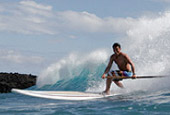 |
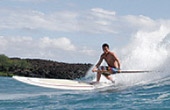 |
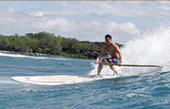 |
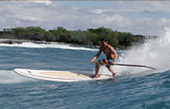 |
| 37 |
38 |
39 |
40 |
| When you are into the waves please put your steering foot ( see also point 5 ) towards the tail of the board. The wave is now moving & accelerating the board, use the paddle as a steering and balance tool and start to ride the wave (pic 30-40). Now you can ride and feel the sensation of Stand Up Paddle Surfing! |
|
|
|
Letter from Stand Up Paddle Surfing Magazine
Editor Bill Ward,
Monday, 19 May
2008
Congratulations on your new board and welcome all to the stand up paddle
surfing community. Stand up paddling is the fastest growing water sport
in the world, and no doubt, you will have many hours of paddling the
beautiful oceans, rivers, harbors, lakes, and perhaps riding waves.
Please remember the following four points, and share them with others,
as you grow with the sport: RESPONSIBILITY, SAFETY, ETIQUETTE, ALOHA
SPIRIT.
RESPONSIBILITY: Whether this is your first time on a stand up
paddleboard or if you have been doing it for years, we ask that you
please take a moment to consider the personal responsibility that you
have. Is starts by making sure you boards are securely tightened to your
vehicle with properly installed racks. Please take an extra moment to
double check every time you transport your boards, as those not properly
fastened can fly off your vehicle and may cause accident or injury. Be
safe and always double check.
SAFETY:
Safety for others and you is something that needs to be top priority
EVERY time you enter the water. ALWAYS be aware of the conditions of the
ocean (currents, swell, crowds, etc.). If you are new to this sport,
please take time to learn your technique in places that have calm, flat,
water. Even if you have a strong surfing background, please remember
that this is a new sport that requires different balance and muscle
groups than you are familiar with. So, do like we all did and put your
pride to the side and take the time to learn this incredible sport the
RIGHT way!
ETIQUETTE: Okay, so now you have mastered flat water paddling and
are ready to start surfing! This is where things get insanely fun!
However, that does NOT mean you should paddle straight into a crowded
lineup at your favorite surf spot. Even if you are an established surfer
there, you will quickly wear out your welcome if you do not demonstrate
proper etiquette.
Start
slowly by going places that offer easy, small, mushy waves where there
are FEW people, if any, around you. You are going to fall off a lot
while learning. (No shame, we ALL did!) When you do fall, you board may
become a projectile toward others. So again, please be aware of your
surroundings and do whatever it takes to surf AWAY from other people.
Once you start to master surfing waves, remember that a bigger board is
in no way a license to be a "wave hog".
ALOHA
SPIRIT: Sharing waves and making friends is not only the right
thing to do, but will make every session enjoyable. Isn't that why we
all got started in the first place? FUN and STOKE! We have an amazing
opportunity to grow this wonderful sport in a positive direction. Let's
all do our part and share the Spirit of Aloha every time we hit the
water.
Welcome
to the sport and enjoy your time on the water. |







